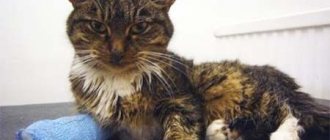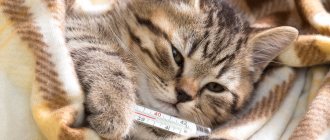Kidney diseases in cats are serious and dangerous pathologies that can lead to the death of the animal. They cause destruction of organ tissue, causing it to cease to perform its functions. The kidneys lose their ability to remove toxins from the blood, secrete urine, and maintain water-salt and acid balance. If you do not notice and ignore the signs of kidney disease in cats, the development of chronic renal failure (CRF), disability and death of the animal is possible.
Kidney structure
The kidneys are a paired oval (bean-shaped in dogs) organ, which in cats is located in the abdominal cavity, in the center of the back (at the level of 7-8 ribs), on both sides of the spine. In this case, the left half may have greater mobility.
The kidneys are made up of nephrons, each of which contains a glomerulus (a collection of capillaries) and a system of tubules. Each nephron is reliably protected from damage by a capsule.
Externally the kidneys look like this:
- The organ is protected from damage by a fibrous capsule, which in turn is located in a fatty capsule, whose thickness depends on the weight of the animal.
- The portal includes the renal artery, through which blood enters the kidneys for purification.
- The renal vein, ureter, and lymphatic vessels emerge from the organ.
- The ureter begins in the renal pelvis and discharges the resulting urine into the bladder.
Causes
There are many causes of nephritis, but the most common signs of the disease in cats are:
- Incorrect use of medications.
- Poisoning with household chemicals.
- Poor nutrition or poisoning from poor quality food.
- Damage to the body by helminthic infestation.
- Hypothermia, injuries, etc.
© shutterstock
Note. Most often among animals, cats are susceptible to nephritis; for example, in dogs this disease appears 3 times less often.
Kidney functions
The main job of the kidneys is to remove toxins from the body. It also forms urine, which contains:
- excess liquids, mineral salts, organic substances;
- uric acid;
- urea;
- ammonia, other metabolic products.
Urine flows down the ureters into the bladder, then comes out during emptying.
Other features
- Maintaining water, electrolyte, acid-base balance;
- regulation of blood pressure;
- removal of excess calcium;
- production of the active form of hormone D;
- synthesis of the hormone erythropoietin, which is responsible for the creation of red blood cells in the bone marrow.
Renin-angiotensin-aldosterone system (RAAS) and CKD
The renin-angiotensin-aldosterone system, or RAAS, is a sequence of hormonal reactions aimed at maintaining blood pressure within a narrow normal range. Strict blood pressure control is achieved by maintaining a balance between the following processes:
- Vasoconstriction
- Vasodilation
- Control of extracellular fluid volume and blood volume by excretion or retention of sodium and water.
Angiotensin II is the active end product of a cascade of hormonal reactions. It binds to angiotensin II receptors on the surface of cells in various tissues and causes various biological effects, which are depicted in Fig. 3.
Rice. 3. Renin-angiotensin-aldosterone system (RAAS) and its effect on homeostasis
Common kidney pathologies in cats
If the kidneys do not work properly, the body begins to malfunction, which can lead to serious problems. The most dangerous lesion is acute or chronic renal failure, untimely treatment of which leads to death. The acute form occurs quickly and is usually a consequence of poisoning.
Chronic kidney disease in cats takes a long time to develop, so it occurs mainly in older animals. It is usually a complication of other diseases of this organ:
- Pyelonephritis is an inflammation of the kidneys caused by bacteria, usually a consequence of cystitis (inflammation of the bladder).
- Polycystic disease is a congenital pathology, often found in pets with long hair.
- Poisoning. Causes include poisonous plants (lilies), pesticides, cleaning products, human medications harmful to animals (ibuprofen, vitamin D).
- Stones in the kidneys or urinary tract that interfere with the flow of urine from the organ.
- Glomerulonephritis – damage to the glomeruli.
- Neoplasia is a tumor, the most common is lymphosarcoma.
- Amyloidosis is an accumulation of protein in an organ that impairs its function.
Diagnosis and treatment in a veterinary clinic
When visiting a veterinary clinic, your pet will be prescribed a number of diagnostic measures to make an accurate diagnosis. This is necessary to exclude other pathologies that can affect the animal’s body. The owner should tell the veterinarian when the first signs appear. The following types of diagnostic measures are prescribed:
- general clinical blood test;
- general urine analysis;
- blood test for biochemical research;
- X-ray examination of organs located in the pelvis;
- ultrasound diagnostics of internal organs.
Any independent prescription of medications without the consent of a veterinarian provokes a worsening of the pet’s condition. By such actions, the owner can provoke the development of complications. Having noticed signs of developing nephritis in a pet, the owner’s main task is to ensure proper nutrition before contacting a veterinarian. Dietary nutrition involves the exclusion of granulated feed, salty and fried foods. It is contraindicated for animals to consume food rich in chemical additives.
After diagnostic measures, based on the data obtained, the veterinarian develops suitable treatment tactics according to the individual needs of the cat. In complicated cases, conservative methods do not produce results and surgical intervention is required.
Depending on the type of nephritis diagnosed, treatment may vary. So, with diffuse nephritis of an acute form, drugs are prescribed aimed at eliminating the underlying cause. Salty foods are removed from the diet, and the pet is provided with rest. The diet should be enriched with protein components. Antibacterial drugs, such as:
- benzylpenicillin;
- ecmonovocillin;
- bicillin;
- gentamicin;
- streptomycin;
- erythromycin.
An excellent treatment effect is obtained by using hormonal-based anti-inflammatory drugs - Prednisolone, Cortisone. Valerian infusion helps with convulsive symptoms. Edema is eliminated with the help of diuretics - Temisal, Furosemide.
The chronic form of nephritis in cats is treated somewhat differently. A sick pet should be kept on a specific diet and receive water enriched with minerals. Conditions must be improved. Therapy with diuretics is mandatory. If a cat has heart failure due to nephritis, cardiac glycosides are prescribed - Gitalen, Dilanizide, digitalis preparations.
A chronic form of nephritis, often accompanied by a bacterial infection. Broad-spectrum antibacterial agents are used. For anemia, iron supplements and vitamins are prescribed - ascorbic acid, B12, ferroglucin. If the animal suffers from problems with the digestive tract, symptomatic treatment is carried out.
Causes of kidney disease in cats
Problems can be caused by both primary and secondary causes:
- Genetic factor - Abyssinian cats and Persians are predisposed to kidney disease.
- Viral infections – feline leukemia (FeLV) or feline infectious peritonitis (FIP).
- Heart failure, which is accompanied by low blood pressure, which reduces blood flow to the organ.
- Trauma associated with a pelvic fracture or bladder rupture.
- Bacterial infections, due to which pathogens were able to get close to the kidneys - chronic periodontal disease, inflammation of the uterus, pancreatitis, endocarditis.
- Worms.
- Autoimmune diseases – lupus erythematosus.
Signs of chronic glomerulonephritis and methods of combating it
Have you been trying to cure your KIDNEYS for many years? Head of the Institute of Nephrology: “You will be amazed at how easy it is to heal your kidneys just by taking it every day...
Chronic glomerulonephritis is an immunoinflammatory chronic kidney disease that initially affects the renal glomeruli and tubules, subsequently spreading to other kidney tissues. Slowly progressing, damaged kidney tissue is replaced by connective tissue, sclerosis occurs, leading to chronic renal failure.
Kidneys are paired organs that perform the function of urine formation through chemical self-regulation of the body, thereby removing foreign compounds and toxic substances from the body. They take part in carbohydrate and protein metabolism and in the formation of a number of biologically active substances.
The main load during blood filtration falls on the renal glomeruli with tubules and Bowman's capsule (nephrons). At the time of birth, nephrons have already formed, but continue to mature for about 10 years. Since new glomeruli are no longer formed after birth, their loss leads to kidney failure.
Upon completion of filtration, urine is excreted through the renal tubule into the renal pelvis, from where it drains into the bladder.
First of all, with glomerulonephritis, changes occur in the nephrons:
Stages
Chronic glomerulonephritis undergoes several stages:
- Compensation stage. This is an early stage in the development of the disease. At this stage, the kidneys are functioning without visible disturbances. There is a moderate increase in blood pressure and slight swelling. A slight increase in protein in the urine, a change in its density, the presence of modified red blood cells. The concentration of urine decreases.
- Stage of decompensation. At this stage, kidney function is impaired and renal failure occurs. Blood pressure numbers are high, the body is poisoned with nitrogenous compounds, and daily urine output increases. The level of protein in the urine increases, the presence of casts and red blood cells increases, and the density of urine decreases.
- Uremia. The most difficult stage. The kidneys cannot maintain the correct composition of the blood. Intoxication with residual nitrogen, creatinine, and urea appears.
Chronic glomerulonephritis can be infectious-immune and non-infectious-immune.
Types of glomerulonephritis:
- Latent glomerulonephritis. The most common type, it accounts for 45% of the total number of patients. Symptoms are mild. Slight increase in blood pressure, mild swelling. The disease can be identified by the results of a laboratory test: protein, red blood cells and white blood cells are increased in the urine. Lasts a long time, up to several decades. Systematic outpatient monitoring of the patient is required. Working capacity is not impaired.
- Hematuric glomerulonephritis is rare, accounting for about 5% of all cases of chronic glomerulonephritis. There is an increased content of altered red blood cells in the urine, which is why the urine is red or pink. Anemia is sometimes observed. Renal failure occurs infrequently, and the course of the disease is favorable.
- Nephrotic glomerulonephritis. It affects 25% of the total number of cases of glomerulonephritis. With this type, the pressure is increased, there is severe swelling, and little urine is produced per day. There is protein in the urine, the density of the urine is increased. In a biochemical blood test, cholesterol is increased and total protein is decreased. This type of glomerulonephritis progresses moderately, but rapid progression is also possible. Kidney failure develops.
- Mixed form of the disease. Occurs in 7% of cases. Repeats the symptoms of hypertensive and nephrotic types. It is characterized by a persistently progressive course and the formation of chronic renal failure.
We suggest you familiarize yourself with: Signs of kidney failure in a cat, symptoms and treatment, diet and food, stages of chronic failure. Any form of the disease has two phases:
- Compensated. The kidneys are working normally.
- Decompensated. The kidneys work with impairment of their functions, chronic or renal failure progresses.
The result of chronic glomerulonephritis is the formation of chronic renal failure. The very first symptom is a decrease in the relative density of urine (isosthenuria) and an increase in the amount of urine excreted per day (polyuria). Diuresis increases at night (nocturia). Signs of uremia appear. The body is poisoned with nitrogenous substances and uremia develops.
Tubulointerstitial nephritis is a disease that is known to a small number of people. According to medical statistics, this disease in most cases affects individuals over 60-65 years of age. Only in 2% of cases is it found in the younger population.
Basic concept
Tubulointerstitial nephritis is a nonspecific disease that affects the liver. A rapidly occurring inflammatory process negatively affects the hepatic soft tissues and its canal passages. If treatment is not started in a timely manner, atrophy is possible. The etiology of this disease varies.
Inflammation of the kidneys is distinguished by the severity of the process. It can be manifest or chronic. Depending on the tissue damage, the following types of disease are distinguished:
- Glomerulonephritis. The kidney glomeruli are destroyed and gradually die.
- Pyelonephritis is a purulent inflammation of the renal pelvis.
- Interstitial. In this case, the kidney tubules become inflamed and urine filtration is impaired. It is rare in cats.
Hurt
Symptoms of kidney disease in cats
Early signs of kidney disease in cats can indicate any other pathology - lethargy, apathy, dull hair, and sometimes baldness. One of the first obvious symptoms of kidney disease in cats is frequent or infrequent urination. In the first case, the urinary system does not retain fluid well. In the second, problems with the formation of urine or stones (tumor) block its outflow.
Other symptoms of kidney disease in cats that indicate the need for treatment include:
- painful urination;
- involuntary emptying outside the tray;
- strong thirst;
- loss of appetite, weight loss;
- mouth ulcers;
- brown tongue
In later stages appears:
- vomiting, diarrhea or constipation, bloody or cloudy urine;
- unpleasant odor of ammonia from the mouth.
Characteristic signs
The symptoms of leukemia are varied. The following signs raise suspicion:
- digestive disorders;
- inflammation of the gums;
- constant illness;
- disheveled fur, oppression;
- enlargement of local lymph nodes;
- anemia;
- eye lesions;
- salivation;
- abortions;
- infertility;
- tumors.
- paresis of the limbs.
Diagnosis of kidney problems in cats
Kidney disease in cats is usually diagnosed based on blood tests for urea and creatinine levels. These protein breakdown products can only be excreted from the body through urine. Therefore, their increased amount in the blood indicates problems with the kidneys. The degree of damage is determined by the number of creatinine, since an increase in urea does not always correspond to the severity of the pathology.
To determine pyelonephritis and other diseases, you need to do a pet urine test for the presence of albumin in the blood. The more protein in the urine, the worse the situation. To diagnose pyelonephritis and other pathologies, it is necessary to do an ultrasound, x-ray, and biopsy.
Until recently, early diagnosis of chronic renal failure was a difficult task. For an accurate diagnosis there were few clinical symptoms, increased levels of nitrogen, urea, and creatinine in the blood. By their level, it was possible to determine CKD only when the organ almost completely failed.
Now there is a blood test SDMA (SDMA), which allows you to determine the loss of kidney function by 25%. Its level rises long before the rise in creatinine in the blood. Even if the kidneys of cats and dogs are slightly damaged, the test can determine the presence of diseases that adversely affect the organ.
Diagnostics
A veterinarian diagnoses feline nephritis. To clarify the nature of the problem, it is often necessary to exclude a number of other pathologies that may have similar symptoms. Diagnosis of the disease begins with examination of the animal and palpation of the kidney area.
The specialist collects anamnesis to determine the conditions in which the cat lives and what food and water it consumes. To identify the problem and the cause of its occurrence, specific tests and examinations are prescribed, including:
- general and biochemical blood and urine tests;
- electrophoresis;
- Ultrasound of the kidneys;
- radiography.
If necessary, additional studies such as MRI and kidney tissue biopsy are prescribed.
Treatment of kidney disease in cats
When treating kidney disease, the veterinarian will pay attention to the level of electrolytes in the blood. You may need to take the following medications:
- Medicines for phosphorus binding are prescribed if the analysis shows their elevated levels in the blood. Reducing phosphorus improves the pet’s well-being and slows down the progression of the disease.
- Potassium supplements. Animals with renal pathology often lose potassium in the urine, which leads to muscle weakness, deterioration of coat condition, and chronic renal failure.
- Vitamins B and C. When the organ stops concentrating urine, they dissolve in urine and are excreted from the body. Therefore, pets need daily supplements.
- Antiemetics are prescribed for the treatment of animals that suffer from disorders of the digestive system.
- Medicines to lower blood pressure. Many pets with kidney failure have elevated blood pressure, which leads to organ destruction.
- Medicines to treat anemia. The kidneys stimulate the synthesis of red blood cells in the bone marrow. When an organ is destroyed, the level of red blood cells drops. This leads to oxygen starvation and disruption of oxidative processes. Treatment with special drugs is aimed at restoring the level of red blood cells in the blood.
- Feed additives that support kidney function - Renal paste, Renaletten.
Nephrosis
This pathology represents metabolic-dystrophic renal pathology with deformation of the urinary canals. The disease is associated with intoxication of the body and changes in metabolism. Renal circulation is disrupted, toxic elements act from the outside. Then it begins to be excreted in large quantities in the urine. Elderly pets often experience proteinuria with high protein concentrations, as well as gastrointestinal disturbances, edema and decreased appetite. The diagnosis is made by a veterinarian based on the clinical picture and the results of a laboratory urine test.
Diet for cats with kidney disease
When the kidneys are sick, the pet suffers from dehydration. During treatment, be sure to provide him with water - give him wet food, low-sodium broth, tuna juice.
Particular attention should be paid to a diet low in protein and phosphorus. Ask your veterinarian how to feed your pet correctly. The diet should contain a reduced amount of phosphorus and protein, enriched with omega-3 fatty acids.
If you give dry cat food, it is not advisable if you have kidney disease. Give preference to high quality wet food. For example, Dr. has proven himself well. Clauder's Diet Kidney diet for kidney disease. If your pet has stones, for treatment, buy food for cats with kidney disease, which reduces the risk of stones.
Treatment: which methods are effective?
Use of pharmaceuticals
All medications and dosage are prescribed by a doctor; self-medication leads to the death of the animal. Treatment of nephritis in cats includes a set of medications shown in the table:
| Pharmgroup | Medication |
| Antibiotics | "Amikacin" |
| "Erythromycin" | |
| "Gentamicin" | |
| "Amoxiclav" | |
| "Amoxicillin" | |
| "Vetrimoxin" | |
| Diuretics | "Furosemide" |
| "Veroshpiron" | |
| "Amiloride" | |
| "Torasemide" | |
| Potassium acetate | |
| Magnesium sulfate | |
| Vitamin complexes | "Aminosol" |
| "Fort Dodge Dufalight" | |
| "Gepavi-kel" | |
| "Tetravit" |
Medical nutrition
Among the abundance of medicinal foods, the owner can choose Purina Veterinary Diets and switch the pet to it.
If you have nephritis, you should exclude salty, smoked, fried, fatty foods from your cat’s diet, and reduce the amount of protein foods. The animal should eat fractionally, in small portions. The menu should include low-fat cottage cheese and kefir, cereal porridge, boiled vegetables and lean broth. Among feeds, preference should be given to those produced for kidney diseases. These include:
- Purina Veterinary Diets;
- Hill's Prescription Diet;
- "Advance";
- Royal Canin;
- "Farmina."
Herbal treatment
The use of herbal infusions for nephritis in cats is mandatory, since herbal remedies accelerate the penetration of antibiotics into the renal structure.
The decoction should be given to the cat through a syringe without a needle, in small portions so that the animal can swallow without choking. Inflammation of the kidneys should be treated with herbs such as bearberry, lemongrass, knotweed, dandelion, immortelle, and flax seeds. You can prepare each herb separately or make a mixture by mixing them in equal proportions. Juniper berries are effective and can be added to food. Preparation:
After brewing bearberry, the owner can give the pet this drink several times a day. Take 5 g of any plant or mixture, pour 200 ml of boiling water.- Let it brew for 20-30 minutes, cool, filter.
- Dilute the resulting broth with boiled water.
- Drink 10-15 ml 3-4 times. per day.
Useful materials:
- Cloudy eye in a cat Common causes of cloudy eyes in a cat The most common causes of cloudy eyes are glaucoma, cataracts or keratitis.…
- Cutaneous horn General description of the disease Cutaneous horn on the forehead or face (ICD 10 code - L57.0) -...
- Itching and odorless discharge Main causesBefore considering the factors that provoke the appearance of discharge that has a sour odor, it is necessary to immediately note...
- A cat’s liver How to determine that there is a malfunction in the liver All harmful substances that enter the cat’s body with ...
Prevention of kidney disease in cats
- Do not keep the animal in cold or drafty conditions.
- Give deworming medications in a timely manner, even if the pet does not leave the apartment.
- Don't forget about annual vaccinations.
- Keep your pet away from household poisons. Hide medicines, flowers (lilies), and household chemicals that could cause poisoning to your cat.
- Feed the animal regularly (2 times a day).
- Discuss your pet's diet with your veterinarian. Give the animal high-quality food, do not overfeed.
- Change the water daily.
- Provide constant access to the tray to avoid urolithiasis. Don't forget to clean it.
- Play with your pet to prevent obesity. Buy special toys for games. A sedentary lifestyle is the cause of stagnation and many diseases.
- Treat kidney and urinary system diseases in cats in a timely manner.
- If your animal is at risk (old age, breed prone to kidney disease), immediately adjust its diet and monitor your pet’s health.
Prevention
Prevention consists of organizing, maintaining comfortable living conditions and balanced feeding. The cat should not be treated to fried, salty, spicy foods, or overfed with scraps of meat and raw fish.
It is necessary to choose the type of feeding, and not mix natural products with ready-made factory-made feed. The cat is dewormed quarterly and protected from infectious diseases by vaccination according to the vaccination plan. If kidney disease is suspected, seek veterinary help.
Symptoms of nephritis
The following signs most likely indicate an inflammatory process in the kidneys:
- increase in body temperature up to 40⁰С;
- muscle aches and lower back pain;
- swelling of the face and limbs;
- darkening of urine;
- decreased number of urinations during the day.
At risk are children and young men, in whom the inflammatory process develops quite quickly and often becomes dangerous.
Treatment of kidney failure
Chronic renal failure cannot be completely cured. By controlling the development of the disease, you can improve the animal’s condition and prolong its life. Treatment tactics depend on the stage of the disease.
If the pathology was detected in the initial stage, it will be necessary to provide the cat with monitoring of vital signs: measure body weight, blood pressure, and monitor the general condition every few months. The problem in this case may be loss of appetite due to the need to follow a “tasteless” diet.
At stages 3-4, if there are no severe clinical manifestations, the therapy will be the same. However, in case of an unstable condition, the cat will have to be brought out of the decompensation stage in a hospital setting. The treatment plan will depend on the symptoms:
- In case of dehydration, infusion therapy is carried out; for this, the cat is given an intravenous catheter.
- Antiemetics (Maropitant, Metoclopramide) are prescribed for vomiting cats.
- If the hematocrit level is very low (anemia), a blood transfusion (blood transfusion) may be prescribed.
- Painkillers are used to relieve pain and inflammation.
After achieving positive dynamics, the cat is prescribed a course of long-term therapy: injections of electrolyte solutions are prescribed to restore water-salt balance, as well as drugs that replenish protein loss.











